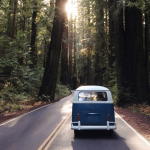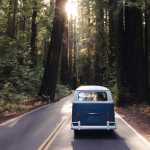One of the greatest adventures any of us can embark on in life surprisingly comes in the form of a road trip. This is because we not only learn about new people and places while we are on the road, we also learn a great deal about ourselves.
The road has a way of bringing you face to face with life, and with yourself. While you might think nothing of the passing scenery aside from how picturesque it is, if you pay attention, you’ll find that you’ve become lost in deep contemplations.
Taking a road trip can be done in many ways. You can just throw caution to the wind, get in the car, and take off. Or, you could plan out your trip thoroughly. The best road trip, however, combines both of these strategies.
You will find that you’ll have a much more engaging experience if you allow yourself room to be spontaneous, while also keeping to a light schedule. Here, we will detail the art of planning the perfect road trip.
Plan Ahead, But Not Too Much
It is often said that proper planning prevents poor performance. While this is true most of the time, planning too much for a road trip can ruin the experience altogether. For example, if you want to plan a bass fishing trip, this is something that takes very little planning, because you cannot depend on the fish biting or the weather being favorable. So, you need to leave room for error or to reevaluate the situation.
The same is true for a road trip. You cannot plan ahead for what might catch your attention or interest you along the way. If you get the urge to make an unscheduled stop, you will run the risk of throwing your entire plan off if you have planned too much along your road trip. But what you can plan for is any toll roads you may encounter, you can search online before you travel, and if you use www.mautgebuhren.de you can order almost all European toll vignettes within minutes, and they will be ready for you instantly.
The best road trip allows for spontaneity, and encourages you to follow your adventurous spirit, wherever this might lead you. So, plan to see a few things, but keep the rest of your itinerary “open to possibility.”
Road Trip Checklist
Any responsible road trip enthusiast, with spontaneity included, needs to have a checklist prior to heading out. This is just as a precaution since the last thing you will want to have happen is getting stranded on a lonely stretch of road.
Your vehicle is the main item that needs to be taken into consideration. The following checklist should be thoroughly verified prior to setting forth on the road:
- Check tire pressure
- Ensure tire tread is roadworthy
- Properly inflate the spare tire
- Ensure you have a working tire jack
- Check for full fluid levels
- Check and change oil and filter
- Check headlights, taillights, and turn-signals
- Check windshield wiper function
- Ensure mirrors and field of vision is free of obstruction
By adhering to the above checklist, you will rest easy as you travel across the country. In addition, it is also a good idea to get a tune-up or have your car inspected by a licensed mechanic prior to any long-distance travel.
In addition to making sure your vehicle is ready to go, you want to also make sure your entertainment is good to go as well. That means making sure you have a great road trip playlist of music to listen to, plenty of drinks and snacks, and scheduled times to switch drivers. This is especially important because depending on where you’re traveling to, the drive can consist of multiple hours on end. Switch drivers will allow everyone to get a bit of rest and enjoy the scenery all the same.
Your road trip checklist is ultimately what will determine whether or not your road trip will be successful.
Maps And Routes
Now comes the fun part. Planning out your route can be a fun experience, and to do this you will want to consult a road atlas and an attractions guide.
Do not frown your face just yet. Believe it or not, maps and atlas were what people used for directions before GPS came out, and it is actually what GPS are based on… (insert sarcasm). But even though these methods of obtaining directions are a bit outdated, they are still very useful and relevant today.
Most road atlases have sat with dust on the shelves for many years as the advances of GPS technology have significantly reduced their need and use. But, an atlas is not simply a map. Most road atlases have points of interest highlighted such as cultural sites, national monuments, historic markers, and other interesting places along all major routes.
You will not find many points of interest on your GPS, and the only way you will be able to find these places is by mapping your route near these locations. So, get yourself an atlas and have fun planning your experience the old-fashioned way.
No matter your destination, remember the best part about taking a road trip is the act of traveling itself. It is on the journey where we make our greatest discoveries.








